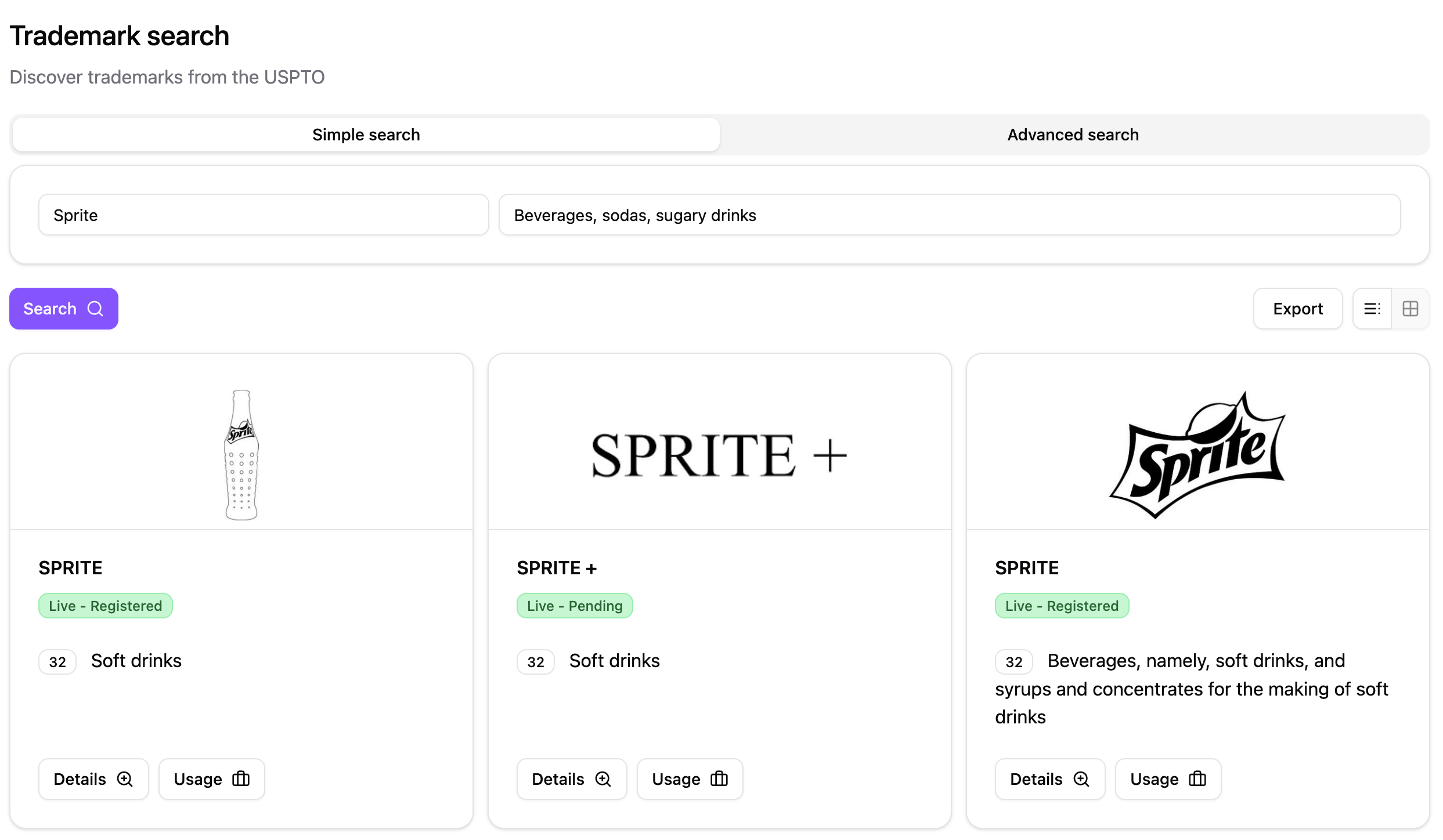The USPTO's Goods and Services Search Problem – How Exact-Match Logic Creates Clearance Gaps
Published by TMChecker Team on 2025-06-07
Trademark conflicts don’t respect rigid category boundaries. A “beverage” company and a “soft drinks” manufacturer operate in identical commercial spaces, yet the USPTO’s goods and services search treats these terms as completely unrelated. This fundamental disconnect between how businesses actually compete and how the government’s search system categorizes them creates a critical vulnerability in trademark clearance.
The consequences extend far beyond semantic quibbles. Courts evaluate likelihood of confusion based on commercial reality—whether consumers might believe two marks originate from the same source. When your clearance search misses obvious overlaps because of technical limitations, you’re building on a foundation that litigation can easily destroy.
The Exact-Match Trap: When Precision Becomes Blindness
The USPTO’s goods and services filtering operates on exact-match logic—a binary system that either finds your precise terminology or finds nothing at all. This approach reflects the rigid structure of the trademark classification system, where each good or service must fit into predefined categories with specific language.
But commercial reality is fluid. Businesses use countless ways to describe identical products and services:
- “Beverages” vs. “soft drinks” vs. “non-alcoholic drinks”
- “Computer software” vs. “mobile applications” vs. “digital tools”
- “Consulting services” vs. “advisory services” vs. “business guidance”
The USPTO system treats each variation as a separate, unrelated category. Search for marks in “beverages” and you’ll miss every registration that uses “soft drinks”—despite operating in identical markets with identical consumer bases.
This isn’t a minor technical limitation—it’s a systematic failure to understand commercial similarity.
Where Exact-Match Logic Breaks Down
Synonym Blindness: The most obvious failure involves straightforward synonyms. “Footwear” and “shoes,” “automobiles” and “cars,” “software” and “applications”—terms that any business professional recognizes as equivalent remain completely isolated in USPTO searches.
Industry Evolution: As markets evolve, terminology shifts. “Computer programs” becomes “software” becomes “apps.” Traditional classification language can’t keep pace with how businesses actually describe their offerings, leaving modern terminology invisible to searches using older classification language.
Market Reality Gaps: Perhaps most dangerous is the system’s inability to recognize overlapping markets. “Energy drinks” and “nutritional supplements” serve similar consumer needs and often compete directly, yet rigid categorization treats them as separate universes.
Granularity Problems: The system fails both ways—sometimes categories are too broad (“computer software” encompasses everything from games to enterprise systems), sometimes too narrow (missing that “mobile apps” and “desktop software” often compete for the same users).
The Commercial Risk
These search gaps create real business exposure:
Hidden Competition: Direct competitors remain invisible because they use different but equivalent terminology. You clear “software” while a conflicting mark exists under “applications.”
False Security: Comprehensive clearance requires understanding the full competitive landscape. Exact-match limitations provide false confidence—the silence doesn’t mean safety.
Litigation Vulnerability: Courts don’t care about USPTO categorization nuances when evaluating consumer confusion. If markets overlap in practice, classification technicalities won’t protect you.
Investment Risk: From product development to marketing spend, business decisions based on incomplete clearance create compounding liability.
The gap between what businesses know to be similar and what the USPTO’s system can find represents unacceptable risk in modern trademark practice.
Semantic Intelligence: How Machine Learning Solves Classification Gaps
tmchecker.com addresses these critical limitations through semantic understanding—machine learning that comprehends meaning rather than just matching text.
True Synonym Recognition: Our embedding technology understands that “beverages,” “soft drinks,” and “non-alcoholic drinks” describe the same commercial space. Search one term and automatically see marks across all equivalent categories.
Market Reality Mapping: Advanced algorithms identify functional overlaps that rigid classification misses. Whether it’s “energy drinks” competing with “nutritional supplements” or “mobile apps” overlapping with “software,” our system recognizes commercial similarity.
Dynamic Classification: Unlike static USPTO categories, our semantic models adapt to evolving market terminology. New business descriptions are automatically mapped to established commercial categories.
Contextual Intelligence: The system understands that similarity depends on context—“apple” as fruit versus technology, “dove” as soap versus chocolate. Semantic matching considers commercial context, not just linguistic similarity.
 tmchecker.com semantic search: “Beverages, sodas, sugary drinks” automatically includes marks from related categories like “soft drinks,” “non-alcoholic beverages,” and “drink mixes.”
tmchecker.com semantic search: “Beverages, sodas, sugary drinks” automatically includes marks from related categories like “soft drinks,” “non-alcoholic beverages,” and “drink mixes.”
The Strategic Advantage
This isn’t just about finding more results—it’s about understanding complete competitive landscapes:
Comprehensive Clearance: See the full spectrum of potentially conflicting marks, regardless of classification terminology differences.
Strategic Intelligence: Understand how competitors position themselves across related categories, revealing market opportunities and threats.
Future-Proof Searching: As markets evolve and terminology shifts, semantic understanding adapts automatically rather than requiring manual category updates.
Confident Decision-Making: Make business decisions based on complete competitive intelligence, not artificial category limitations.
Beyond Technical Solutions: Understanding Business Reality
The fundamental issue isn’t technical—it’s conceptual. The USPTO’s exact-match approach treats trademark classification like a filing system when it should function like market intelligence.
Effective trademark clearance requires understanding commercial similarity, competitive overlap, and consumer perception. These factors transcend rigid categorization schemes and demand tools that comprehend business reality.
tmchecker.com bridges this gap by applying semantic intelligence to trademark searching. Instead of fighting against classification limitations, our platform works with how businesses actually operate and compete.
The New Standard for Clearance
Traditional exact-match searching leaves critical gaps that modern businesses can’t afford. When “beverages” misses “soft drinks,” the system fails at its fundamental purpose—identifying potential conflicts before they become legal problems.
tmchecker.com provides the semantic intelligence required for comprehensive clearance in today’s complex marketplace. Our machine learning understands commercial similarity the way courts and consumers do—based on actual market overlap, not technical categorization.
In trademark clearance, incomplete intelligence creates complete risk. Don’t let USPTO classification limitations compromise your clearance strategy.
Experience comprehensive goods and services intelligence at tmchecker.com—where semantic understanding meets trademark searching.